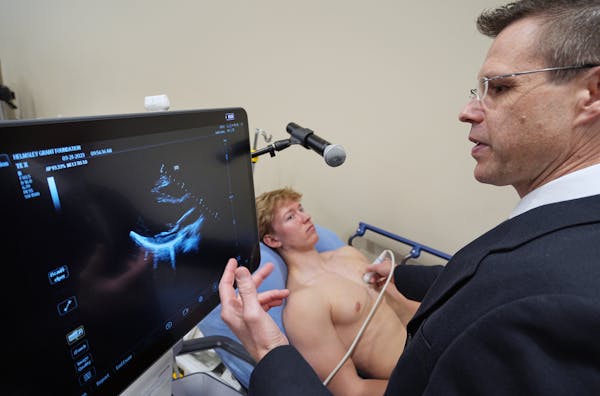M Health Fairview's goal of achieving the world's best cardiac arrest survival rate was boosted Tuesday by a $10 million grant that will substantially increase its response capacity.
The funding, from the Helmsley Charitable Trust, will expand the heart-lung bypass capacity at the University of Minnesota Medical Center in Minneapolis and a mobile program that extends this technology to surrounding hospitals and communities.
Known as extracorporeal membrane oxygenation, or ECMO, the technology oxygenates blood outside the body and keeps it flowing through patients until doctors can fix the causes of their heart stoppages.
"This approach will soon become a model for the rest of the nation and around the globe," said Walter Panzirer, a trustee for Helmsley, which has funded more than $100 million in rural and emergency medical innovations in Minnesota.
Only 10% of patients survived cardiac arrests that occurred outside of hospitals in Minnesota in 2022, according to the latest data from the national CARES registry. The national rate was 9.3% that year.
The opportunity to increase survival comes with the one in three cardiac arrests caused by arrhythmias, or irregular heartbeats, that can be shocked back into rhythm with defibrillators, said Dr. Demetris Yannopoulos, the director of the U's Center for Resuscitation Medicine and a global expert on ECMO use for cardiac arrest.
The survival rate for these arrests is already much higher at 25% to 40% in Minnesota, but it could increase to 70% if ECMO was used when defibrillators failed to restore stable heartbeats, he predicted.
"No one has ever seen anything like this, but I think it's absolutely doable," he said.
Yannopoulos led one of the nation's first randomized clinical trials that compared the use of ECMO with standard resuscitation techniques. It was halted early when the results were obvious.
Only one of 15 cardiac arrest patients survived with standard care, compared with six of 14 patients who received ECMO, according to the study, which was published in late 2020 in the Lancet medical journal.
Usage of ECMO increased so rapidly after those results that the U hospital needed to expand. The Helmsley funding will allow the hospital to double its capacity to 12 critical care beds for ECMO patients. It also will become a training hub, allowing doctors in the Upper Midwest to learn how to diagnose the need for ECMO and then carry it out.
The expansion is remarkable, considering that U researchers only started exploring the use of ECMO for cardiac arrests a few years ago, said James Hereford, chief executive of Fairview Health, which operates the university hospital in partnership with the U.
"If you're going to have a sudden cardiac event — not that we're asking anyone to have one — but if you are, this is the place," he said.
Some studies worldwide haven't achieved the same results as the U trial, but all of them have found that delays are a challenge. Patients left with inadequate blood flow for 40 or more minutes have less chance of survival, even after ECMO artificially restores circulation.
Mayo Clinic cited the U trial results in February when it announced the creation of a rapid ECMO response protocol to reduce delays. Paramedics in the field alert the Rochester hospital, which assembles an emergency team to provide ECMO to inbound patients.
"Our hope with this process is to identify the right patient earlier and to get them here sooner, and to have all the resources already in the room," said Dr. Alexander Finch, a Mayo emergency physician, earlier this year.
M Health Fairview and a consortium of first-responder agencies in the Twin Cities have used prior Helmsley funding to create mobile solutions to the delay problem.
The consortium uses SUVs to transport ECMO teams and equipment to Twin Cities hospitals receiving patients in cardiac arrest. It also built a "super ambulance" that is stationed at Edina Fire Station 1 and can bring ECMO technology directly to hospitals and emergency scenes in the west metro and some surrounding rural areas.
John Sauer of Chanhassen was among the first patients to receive ECMO in the special ambulance after unexpectedly suffering a cardiac arrest two years ago. He collapsed shortly after mowing the lawn, and his wife performed CPR until medics arrived.
Sauer attended the Helmsley funding announcement on Tuesday and stepped inside the ambulance in which he received ECMO. The oversized rig contains imaging technology that medical teams used to safely insert tubes in his body, so the ECMO machine could take over pumping blood.
Now 62, Sauer doesn't remember much of the incident. He woke up in the U hospital and learned that a blockage in one of his blood vessels caused the arrest. He is grateful for all the things that were done to save his life.
"I've gotten another birthday since my cardiac event," he said.
Wolves vs. Nuggets is set. Here's everything we know about Round 2.

Gun safety bills may hinge on one senator's fate despite House support, likely passage

At the U, another pro-Palestinian protest camp goes up

Falcon Heights, St. Anthony nearing police partnership severed after Philando Castile's killing

